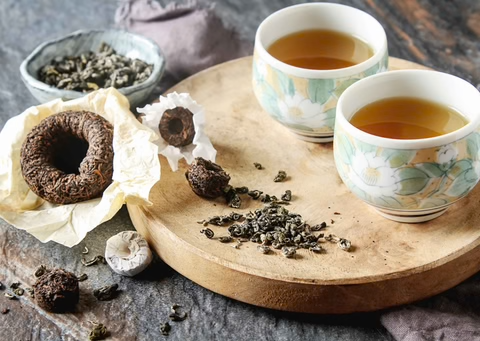Introduction
While green, black, oolong, and white teas often take center stage in discussions about tea, the world of tea is vast and diverse, encompassing a range of lesser-known varieties that offer unique flavors and experiences. Among these are Pu-erh and Yellow tea—both steeped in history and tradition, yet often overlooked by the casual tea drinker. This post delves into the distinctive characteristics and flavor profiles of these two exceptional teas, inviting you to explore the rich tapestry of tastes they offer.
Pu-erh Tea
- Origin and History
- Geographical Indication: Pu-erh tea hails from Yunnan Province in China and is named after the ancient trading town of Pu’er.
- Historical Significance: Traditionally traded along the Tea Horse Road, Pu-erh was valued for its ability to improve with age and its suitability for long-distance travel.
- Processing Methods
- Harvesting: Leaves are picked from the large-leaf variety of the Camellia sinensis plant, sometimes from ancient wild tea trees.
- Withering: Fresh leaves are spread out to wither under the sun, reducing moisture content.
- Kill-Green (Sha Qing): Leaves are pan-fired to halt enzymatic oxidation.
- Rolling: Leaves are gently rolled to shape them and break down cell walls.
- Fermentation:
- Sheng (Raw) Pu-erh: Undergoes natural fermentation over years or decades.
- Shu (Ripe) Pu-erh: Accelerated fermentation through a process called “wo dui” (wet piling) for several weeks.
- Compression: The tea is often pressed into cakes, bricks, or tuo cha (bird’s nest shapes) for aging and storage.
- Unique Characteristics
- Aging Potential: Pu-erh is one of the few teas that improves with age, developing complexity over time.
- Microbial Fermentation: Involves beneficial bacteria and fungi, contributing to its unique flavor and potential health benefits.
- Flavor Profile
- Sheng Pu-erh:
- Young: Assertive, astringent, with vegetal and floral notes.
- Aged: Mellow, earthy, with notes of dried fruit, wood, and a sweet aftertaste.
- Shu Pu-erh:
- Flavor: Smooth, earthy, and rich, with notes of dark chocolate, peat, or damp forest floor.
- Aroma: Deep and mellow, sometimes with a hint of camphor or spice.
- Body: Full-bodied with a lingering finish and minimal astringency.
- Sheng Pu-erh:
- Health Benefits
- Digestive Aid: Traditionally used to aid digestion and reduce bloating.
- Cholesterol Management: Some studies suggest it may help lower LDL cholesterol.
- Antioxidants: Contains unique compounds formed during fermentation.
Yellow Tea
- Origin and History
- Geographical Regions: Primarily produced in China’s Anhui, Hunan, and Sichuan provinces.
- Historical Prestige: Once reserved for emperors and high-ranking officials due to its complex production and rarity.
- Processing Methods
- Harvesting: Young buds and leaves are carefully picked.
- Kill-Green: Similar to green tea, leaves are pan-fired to stop oxidation.
- Sweltering (Sealing Yellow):
- Wrapping: Leaves are heaped and wrapped in cloth or paper.
- Gentle Oxidation: Allowed to sit in a warm, humid environment, promoting slight oxidation.
- Duration: This process can take from several hours to days and may be repeated multiple times.
- Drying: Final drying stabilizes the tea for storage.
- Unique Characteristics
- Micro-Oxidation: The sweltering process imparts a yellowish hue and unique mellow flavor.
- Labor-Intensive: Requires meticulous control, contributing to its limited production and higher cost.
- Flavor Profile
- Taste: Smooth, sweet, and mellow with subtle notes of apricot, peach, or sweet corn.
- Aroma: Delicate and fresh with hints of fruit and floral undertones.
- Body: Medium-bodied with a silky mouthfeel and low astringency.
- Health Benefits
- Antioxidants: Rich in polyphenols, offering benefits similar to green tea.
- Digestive Comfort: Gentle on the stomach due to its mild nature.
- Metabolic Support: May aid in metabolism and overall wellness.
Comparison and Contrast
- Processing Techniques:
- Pu-erh: Involves microbial fermentation and aging; can be consumed young or aged for decades.
- Yellow Tea: Undergoes a unique sweltering process, leading to slight oxidation and distinctive flavor.
- Flavor Complexity:
- Pu-erh: Offers a broad spectrum from bold and earthy in Shu Pu-erh to more nuanced, evolving flavors in aged Sheng Pu-erh.
- Yellow Tea: Presents a refined and subtle palate, bridging the gap between green and white teas.
- Aging and Storage:
- Pu-erh: Designed to age; proper storage enhances its quality and value.
- Yellow Tea: Best enjoyed fresh to appreciate its delicate flavors.
- Cultural Significance:
- Pu-erh: Integral to Yunnan’s cultural heritage; often involved in traditional ceremonies.
- Yellow Tea: Historically associated with imperial courts; less prevalent in modern tea culture.
Conclusion
Pu-erh and Yellow teas exemplify the rich diversity of the tea world beyond the mainstream varieties. Pu-erh’s depth and complexity, born from its unique fermentation and aging processes, offer a dynamic tasting experience that evolves over time. Yellow tea’s subtlety and rare processing methods provide a gentle yet flavorful cup that is both soothing and intriguing. Exploring these lesser-known teas not only broadens your palate but also deepens your appreciation for the intricate art and cultural heritage embedded in every leaf. Whether you’re a seasoned tea aficionado or a curious newcomer, venturing into the realms of Pu-erh and Yellow tea promises a rewarding journey through the nuanced landscapes of flavor and tradition.
